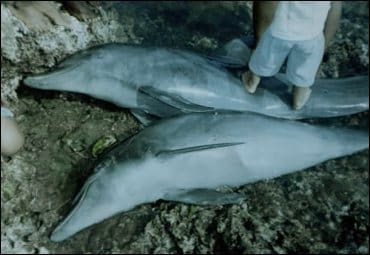Captive Dolphins
Captive dolphins lead short, miserable lives (2007)
“By far, the largest holder of killer whales is Sea World, Inc. My copy of the NOAA report from a couple of years ago shows 62 killer whales in Sea World’s inventory, of which 29 have died. Since many of Sea World’s whales were taken from the wild, information about birth dates is sketchy. But of the four dead animals that show an actual or estimated birth date, one lived a month, one lived 2 years, one lived 11 years and one, a female, lived 23 years, or about half of her estimated life expectancy in the wild.
Another 12 whales show only a captivity date and a death date, with life spans in captivity that range from 1 year to 19. The average for these 12 whales was about 9 years.
Causes of death are interesting, as well. Here’s a sampling: severe trauma, intestinal gangrene, acute hemorrhagic pneumonia, pulmonary abscession, chronic kidney disease, chronic cardiovascular failure, septicemia, influenza, necrosis of cerebrum. And so on. Only one is said to have died of “old age,” though this attribution is dubious, since his birth date is unknown” more….
Dolphins dying to be in Captivity – Fact Sheet
The Case Against Marine Mammals in Captivity:
- Fewer than 5% to 10% of zoos and aquaria are involved in substantial conservation programs. The amount spent on these programs is a mere fraction of the income generated by the facilities. Simply exhibiting wildlife is not considered conservation.
- Whale and dolphin captures still occur routinely around the globe, particularly in the Caribbean, Asia, Russia, and the south Pacific. Most of these captures are inhumane and result in numerous deaths.
- Dolphin sea pen enclosures in Asia and the Caribbean are considered to be at extreme risk from hurricanes and tsunamis. Their construction also degrades coastal habitat, destroying mangroves and damaging coral reefs.
- Swim-with-the-dolphins encounters are proliferating throughout the Caribbean and Asia. These facilities are largely unregulated—even in the United States, the swim-with regulations have been suspended since 1999—and most of the newest ones are being stocked with wild-caught dolphins from unstudied populations.
- Bottlenose dolphins face a six-fold increase in risk of mortality immediately after capture from the wild and immediately after every transfer between facilities. They never become accustomed to transport, and the stress they experience can be fatal.
Which law has been set up to protect dolphins in the United States?
It would be more correct to ask which law has been set up to regulate dolphins in the United States. The law is not protecting dolphins from the harm and harassment connected with capture and captivity; the law simply clarifies what specific rules apply to the capture and confinement of these animals. There is a big difference between animal protection and animal regulation.
The Marine Mammal Protection Act (MMPA) was implemented in 1972 and prohibits the capture of dolphins, or any other marine mammal, from US waters or by US citizens in international waters except by special permit.
When a US facility or individual wants to capture a dolphin, how is a permit obtained?
When an individual or institution wants to capture a dolphin, a capture permit is required. A person or facility can obtain such a permit by submitting an application to NMFS. NMFS then refers the application to its Marine Mammal Commission (MMC). Once the application has been published in the “Federal Register,” the public is given 30 days to make comments to the application. It is during this 30-day period that animal welfare organizations and individuals send letters to NMFS to object the proposed capture.
Under the MMPA is it illegal to perform a so-called “take” of a marine mammal — the term “take” is defined as “to hunt, capture, kill or harass or attempting to do any of these things” — without the proper permit from NMFS. A permit to capture a dolphin may be granted by NMFS for the purpose of the following: Scientific research, public display, accidental captures by fishermen, conservation, and in case of a dolphin stranding. A few examples of how the law works: It is by means of a permit from NMFS that millions of dolphins have been killed in the tuna fishing industry. It is also by means of a permit from NMFS that the US navy captures dolphins and other marine mammals for use in their marine mammal program. These are examples of how the law, rather than protect dolphins, works to protect those who want to make use of these animals, be it for warfare or profitable dolphin shows.
1. The facility must offer what is called a “professional education program.”
2. The facility must be open to the public on a regular basis.
3. A person or institution can only keep a marine mammal on public display (exhibition, including interactive programs) if they are licensed under the Animal Welfare Act. (AWA, implemented in 1979.)
How to speak intelligently about Survival Rates
-
- The average life span of a dolphin in the wild is 45 years; yet half of all captured dolphins die within their first two years of captivity. The survivors last an average of only 5 years in captivity. (Dolphin Project Europe, 1996)
This is incorrect. 45 years is the (maximum) longevity for dolphins in the wild, not the average life span (life expectancy) (Wells and Scott, 1990). The same study showed that the Annual Survival Rate for the Sarasota population was 0.961, which translates to a life expectancy of about 25 years. Small and DeMaster (1995) calculated an ASR for the captive population of 0.951, which translates to a life expectancy of 19.9 years. If the life expectancy in captivity would be only 5 years, the associated ASR would be 0.819, which is not even close to the measured value.
- The average life span of a dolphin in the wild is 45 years; yet half of all captured dolphins die within their first two years of captivity. The survivors last an average of only 5 years in captivity. (Dolphin Project Europe, 1996)
-
- At least 134 orcas (killer whales) have been taken into captivity from the wild since 1961. One hundred and three (77%) are now dead (WDCS, 1999)
While this information may be correct, no conclusions can be derived from this since no timing details are given which would allow the calculation of animal days or years. - Of the 103 which died, average length of survival in captivity was under six years (range: 1 day – 27.2 years) (WDCS, 1999)
Selecting data on animals based on the fact that they are dead introduces a bias towards the shorter lived individuals. The ones that are doing better and are still alive are excluded from the statistics.
- At least 134 orcas (killer whales) have been taken into captivity from the wild since 1961. One hundred and three (77%) are now dead (WDCS, 1999)
-
- Of 54 known pregnancies in captivity since 1968, only 21 calves (39%) have survived. (WDCS, 1999)
This seems to suggest that calf survival in captivity is low. While a 39% survival rate may seem low, it is in the same order of magnitude as wild calf survival, estimated by Olesiuk et al (1990) at 43% for the BC population.
- Of 54 known pregnancies in captivity since 1968, only 21 calves (39%) have survived. (WDCS, 1999)
-
- Another indicator that dolphins are living as long in zoological collections as in the world is research by Drs. Deborah Duffield of Portland State University and Randall Wells of the Chicago Zoological Society. Their data show that the average age of dolphins in their natural environment is similar to that of dolphins in public display facilities. This work corroborates a study published in 1988 by DeMaster and Drevenak (Marine Mammal Science, 4:297-311, 1988) which pointed out that survival of dolphins in aquariums “may be better than or equal to survival in the wild.” (Dolphin Quest, 1999)
The Duffield and Wells (1991) study quoted uses average age of animals as an indicator. As pointed out earlier, this is not a reliable measure, unless the populations have been stable for a long period of time. This is uncertain for the Sarasota population and not true for the captive population. In addition, the quote from DeMaster and Drevenak (1988) is incorrect. Actually, they noted: ” At this time it is not possible to compare survivability of animals in captivity with that of animals in the wild. Additional data from free-ranging animals are needed to determine if captive animals have similar life expectancies.”
- Another indicator that dolphins are living as long in zoological collections as in the world is research by Drs. Deborah Duffield of Portland State University and Randall Wells of the Chicago Zoological Society. Their data show that the average age of dolphins in their natural environment is similar to that of dolphins in public display facilities. This work corroborates a study published in 1988 by DeMaster and Drevenak (Marine Mammal Science, 4:297-311, 1988) which pointed out that survival of dolphins in aquariums “may be better than or equal to survival in the wild.” (Dolphin Quest, 1999)
- The average life expectancy for bottlenose dolphins in their natural environment in the best studied population is 7.0 years for females and 10.1 years for males. The average age at death for captive bottlenose dolphins over the last 20 years has been 11.1 years for females and 10.9 years for males. (Minnesota Zoo, 1999)
This is an incorrect quote from the Duffield and Wells (1991) paper. The numbers quoted are the average ages at death recorded, not life expectancies (the paper does not mention life expectancies). Also the numbers involved are low: the age at death for wild females was based on only one animal (the only confirmed female death).

Picture: KATE GERAGHTY
Hints and tips
When you get involved in discussions about captive marine mammal survival, keep the following things in mind:
- look out for false comparisons (like comparing longevity with life expectancy)
- stay away from life expectancy estimates: use survival rates instead.
- verify claims about life expediencies and survival times by converting them to survival rates.
- know and verify the published data about this subject.
- look for proper reasoning in your own statements and those of others. A useful tool for this is the Baloney Detection Kit (Sagan, 1996).
